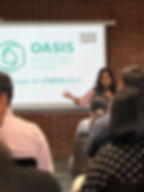Our Moment of Courage: Building an Open-Source Suite of Tools for Nonprofits
- Akhila Somanath
- Jul 28
- 4 min read
“Courage doesn’t always roar. Sometimes courage is the quiet voice at the end of the day saying, ‘I will try again tomorrow.’” — Mary Anne Radmacher
This blog, my first ever (so be kind!), is a tribute to one of the most defining and courageous decisions our team ever made. It's not about overnight success or a eureka moment. It’s about a quiet but powerful choice to walk a more meaningful path—even when it looked harder.
We didn’t start with the goal of building open-source software. We started with a simple but urgent question:
How can we strengthen the tech capabilities of nonprofit organisations in India without overwhelming them?
Over the last five years, our team at Tech4Good Community threw ourselves into solving this puzzle. We launched awareness programs, ran capacity-building workshops, and played tech matchmaker for nonprofits—curating, testing, and recommending tools that could help them manage their operational and programmatic data.

We focused our efforts around three recurring blockers:
Budget constraints: Tools were expensive. Discounts helped, but only went so far.
Lack of in-house tech capacity: Even the best software means little if the team feels lost using it.
Lack of awareness of what’s even possible: Because when you Google “CRM for nonprofits,” the internet assumes you’re a million-dollar enterprise in Palo Alto.
We became the in-house tech translators-breaking down jargon, offering honest recommendations, and sitting beside NPOs as they navigated their digital growing pains.
But we also kept an eye on the deeper story, why some tools landed, and others got shelved. We tracked the churn. Noticed the friction that didn’t always have a name. And every time an NPO dropped off despite our best efforts, we asked ourselves: What are we still not seeing?
Pivot, Pivot, Piiiivooot!
Remember that Friends episode where Ross tries to get a couch up a narrow stairwell yelling “Pivot!” repeatedly?That’s what it felt like.

We were pushing proprietary tools up the nonprofit staircase, greasing every corner—but something just wouldn’t fit. And then came a 30-minute conversation that changed everything.

A call with our mentor and friend, Kailash Nadh.He asked,
Why are you advocating proprietary software so strongly? Why not open-source?
My answer was honest: “Because open-source tools are hard to deploy. The support ecosystem is patchy. Customisation needs engineers, and nonprofits barely have capacity.”
But somewhere in that call, I quietly thought to myself, If we had the right support, we’d do it in a heartbeat. Because deep down, we knew: open-source is what truly empowers the sector in the long run. I jumped off that call and dialed Rinju and Anusha—my fellow co-founders, partners-in-pivot, co-dreamers and my dearest friends.
One 30-minute WhatsApp call later, we made the biggest decision we’ve ever made:

We would become an open-source-first organization.
We gave ourselves 20 days to reimagine everything from how we work to why we work. This wasn’t just a pivot in strategy; it was a quiet promise to ourselves: that every line of code we wrote would carry purpose, not just functionality.
Laying the Foundation: Code, Courage, and Caffeine
From the beginning, we agreed on one rule: No reinventing the wheel. No building software for the sake of it. If we built it, it would be meaningful. It would matter. And it would meet nonprofits where they are.

We assembled a passionate engineering team—a small but mighty crew who code with empathy (and excellent memes). We trained ourselves in open-source frameworks, reverse-engineered tools with zero documentation, and figured out how to bend software to fit nonprofit workflows. Out of this energy, we launched FOSSFwd—a program to configure and build data systems for nonprofits, and contribute back to the open-source sector as we went.
In just 8 months:
We received 380+ build requests & fulfilled 33 custom builds
Our team: 4 fantastic engineers + 1 unstoppable product lead
We didn’t just build products. We built trust. And most importantly, we built something rare in tech: a team that believed in each other. Every decision was made collaboratively. No hierarchy, just hustle. The leadership quietly played parachute while the team shot for the stars. We learned a lot. Mostly what not to do. Building custom tools at scale? Not sustainable.
So we asked: Do we scale by hiring more engineers to serve individual requests, or build systems that solve for 80% of needs at once?
To us, the choice was clear. We weren’t here to sprint. We’re running a marathon. With snacks. And heart.
Patterns, Puzzles, and a Plethora of Possibilities
Once the 33 builds were done, we looked at the data. 49% of the 380 requests were for fundraising management tools.
We had already built five different donor management systems. Each one is slightly different. But the core? Remarkably similar.

We paused and asked ourselves: Are we staring at a constellation of individual requests that could be reimagined as a single pattern? With the 80:20 principle in mind, we set out to research fundraising workflows. We weren’t just designers. We were also the harshest users. If we—overly critical tech dreamers—found the tool intuitive, we were probably on to something. We spoke to over 100 NPO founders and fundraising teams. Not to validate an idea, but to validate if this should even be solved by a software. Because not every gap deserves a digital fix.
Sometimes, it’s a process. Sometimes, it's people.
